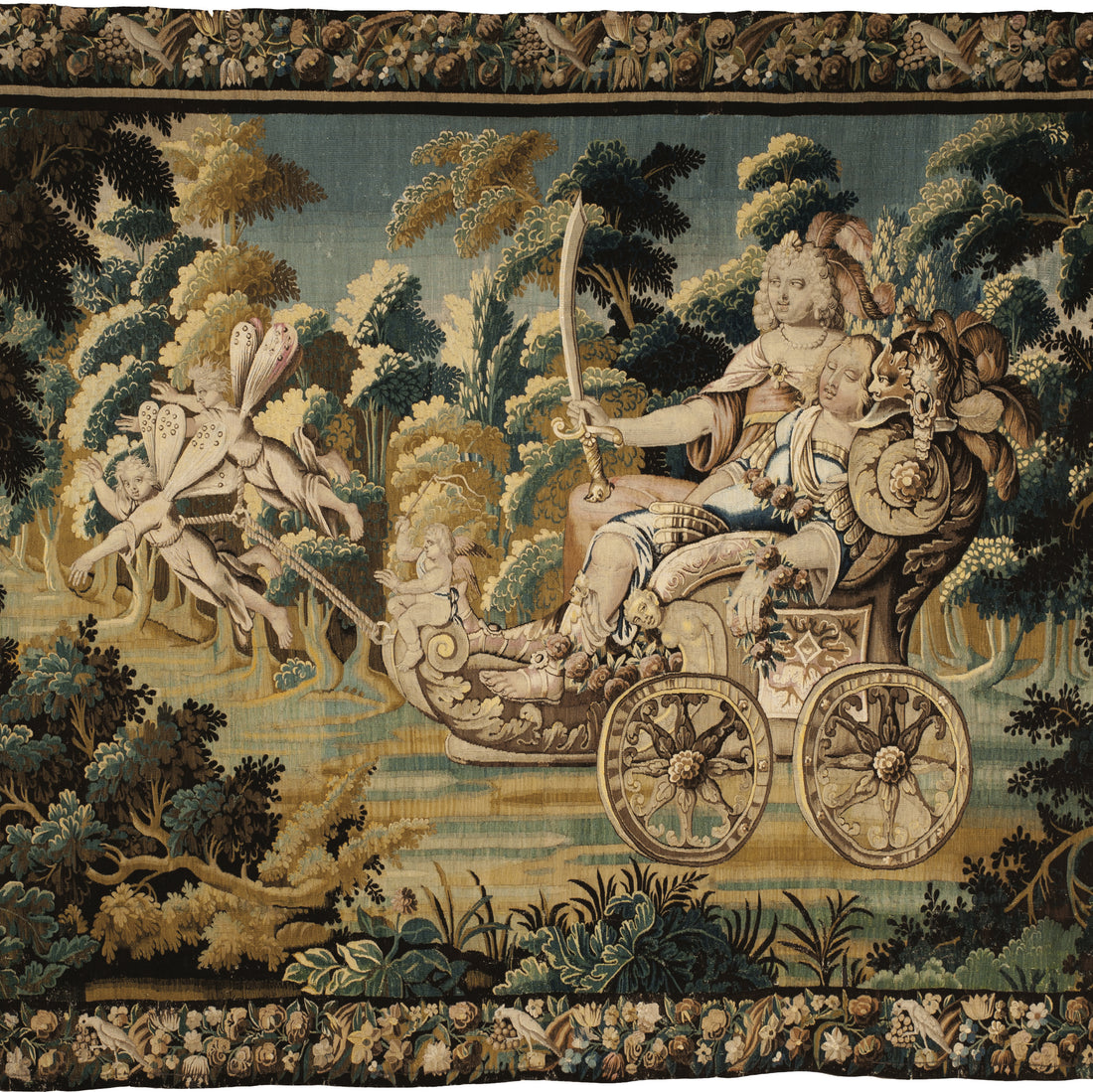
TAPESTRY TALES: AUBUSSON
Image: Armide enlève Renaud endormi sur son chariot, Aubusson region, 17th century © Cité Internationale de la Tapisserie.
This week, Deborah Nash, will be filling our blog with tapestry tales and contemporary weavings with different types of natural and synthetic hair. Deborah Nash is based in Brighton but once lived in Nanjing, China and Bourges, France. Her work includes magazine features, theatre productions, short stories and texts on shirts and dresses. She has been published in literary magazines such as: Ambit, Litro, The Mechanics' Institute Review and Stand and one of her text/textile works was picked by Yinka Shonibare for display at the Royal Academy Summer Exhibition 2021.
The town of Aubusson on the banks of the river Creuse is known as the capital of tapestry in France. The place bustles with weavers, textile restorers and dyers involved in some aspect of a craft that goes back to the 16th century when Flemish weavers arrived in Aubusson and nearby Felletin to escape the ravages of war. A good supply of soft water, cheap labour and wool meant conditions were right for tapestry weaving. Today, there’s a substantial museum, workshop and research centre based in Cité Internationale de la Tapisserie, which holds an impressive collection of antique tapestries, which must inspire today’s weavers to create new works using traditional techniques. When I visit, the early tapestries from 1480 and 1530 catch my eye.
The first shows a spotted bearded unicorn standing on its hind legs holding a plumed blue helmet and a red shield emblazoned with a lion in a similar pose. In the background are clumps of geometric flowers, an example of a space-filling technique called Millefleurs.

Image: Millefleurs a la Licorne, Aubusson region, 1480-1510, © Cité Internationale de la Tapisserie.
The second is a ‘Verdure’ tapestry (stylised foliage) depicting a profusion of large curling leaves and fruit trees where fantastical animals cavort with real ones like the turkey and dove, and evidence of man is removed to a distant settlement.
“These tapestries [‘verdures’] almost never feature human characters, they remain illustrations of an impenetrable universe of vegetation and animals, on the edge of civilisation,” says the museum’s website.

Image: Les Verdures à Feuilles de Choux, Aubusson region, 16th century © Cité Internationale de la Tapisserie.
La Cité also displays examples of ‘La Narration Continue’ (different scenes combined in a single tapestry) and ‘La Tenture’ (where a story splits between several wall hangings). Five weavings from the 17th century narrate the tale of Armide and Renaud with its concluding moral that true love wins the day. The tapestry pictured here is a rare illustration of the enchantress Armide, who’s stolen the sleeping knight Renaud away in her chariot pulled by winged cherubs. She’s seated above him and, in a reversal of gendered roles, brandishes a sword in her hand.
This week, Deborah Nash, will be filling our blog with tapestry tales and contemporary weavings with different types of natural and synthetic hair. Deborah Nash is based in Brighton but once lived in Nanjing, China and Bourges, France. Her work includes magazine features, theatre productions, short stories and texts on shirts and dresses. She has been published in literary magazines such as: Ambit, Litro, The Mechanics' Institute Review and Stand and one of her text/textile works was picked by Yinka Shonibare for display at the Royal Academy Summer Exhibition 2021.
The town of Aubusson on the banks of the river Creuse is known as the capital of tapestry in France. The place bustles with weavers, textile restorers and dyers involved in some aspect of a craft that goes back to the 16th century when Flemish weavers arrived in Aubusson and nearby Felletin to escape the ravages of war. A good supply of soft water, cheap labour and wool meant conditions were right for tapestry weaving. Today, there’s a substantial museum, workshop and research centre based in Cité Internationale de la Tapisserie, which holds an impressive collection of antique tapestries, which must inspire today’s weavers to create new works using traditional techniques. When I visit, the early tapestries from 1480 and 1530 catch my eye.
The first shows a spotted bearded unicorn standing on its hind legs holding a plumed blue helmet and a red shield emblazoned with a lion in a similar pose. In the background are clumps of geometric flowers, an example of a space-filling technique called Millefleurs.

Image: Millefleurs a la Licorne, Aubusson region, 1480-1510, © Cité Internationale de la Tapisserie.
The second is a ‘Verdure’ tapestry (stylised foliage) depicting a profusion of large curling leaves and fruit trees where fantastical animals cavort with real ones like the turkey and dove, and evidence of man is removed to a distant settlement.
“These tapestries [‘verdures’] almost never feature human characters, they remain illustrations of an impenetrable universe of vegetation and animals, on the edge of civilisation,” says the museum’s website.

Image: Les Verdures à Feuilles de Choux, Aubusson region, 16th century © Cité Internationale de la Tapisserie.
La Cité also displays examples of ‘La Narration Continue’ (different scenes combined in a single tapestry) and ‘La Tenture’ (where a story splits between several wall hangings). Five weavings from the 17th century narrate the tale of Armide and Renaud with its concluding moral that true love wins the day. The tapestry pictured here is a rare illustration of the enchantress Armide, who’s stolen the sleeping knight Renaud away in her chariot pulled by winged cherubs. She’s seated above him and, in a reversal of gendered roles, brandishes a sword in her hand.

1 comment
As always a wonderful informative article thanks for sharing this info.